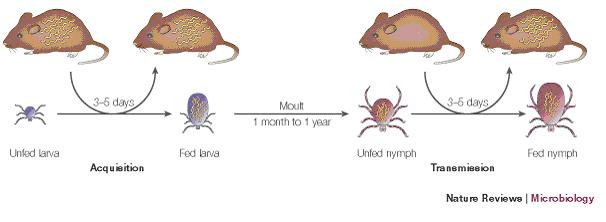Borrelia burgdorferi
A Microbial Biorealm page on the genus Borrelia burgdorferi
Classification
Higher order taxa
Bacteria; Spirochaetes (Phylum); Spirochaetes (Class); Spirochaetales; Spirochaetaceae
Species
Borrelia burgdorferi
|
NCBI: Taxonomy |
Description and significance
Borrelia burgdorferi is a spirochete bacteria that causes Lyme disease. The disease was first diagnosed in the 1970's in Lyme, CT and soon after in 1982 B. burgdorferi was identified as the causative agent. It was determined that the bacteria was being transmitted by ticks. Since then, according to the Center for Disease Control, Lyme disease caused by B. burgdorferi has become the most common vector-borne bacterial disease in the world. It's complete genome has recently been sequenced and is being used to answer interesting questions surrounding vector transmission, host adaptation and plasmid maintenance.
Describe the appearance, habitat, etc. of the organism, and why it is important enough to have its genome sequenced. Describe how and where it was isolated. Include a picture or two (with sources) if you can find them.
Genome structure
B. burgdorferi has a very unique genome. It consists of one large linear chromosome that is 910,725 base pairs long. This chromosome contains approximately 853 genes coding for basic functions such as DNA replication, transcription, translation as well as transport and metabolic systems. However, in addition to this chromosome, the bacteria also contains 21 other linear and circular plasmids that add an additional 533,000 base pairs of DNA. The sequenced genome however does not contain any regular or obvious genes coding for virulence, and therefore, the mechanisms of B. burgdorferi pathogenesis are still being researched.
Describe the size and content of the genome. How many chromosomes? Circular or linear? Other interesting features? What is known about its sequence?
Does it have any plasmids? Are they important to the organism's lifestyle?
Cell structure and metabolism
Describe any interesting features and/or cell structures; how it gains energy; what important molecules it produces.
Ecology
Borrelia burgdorferi is maintained in a natural cycle of infection by ticks. The ticks acquire and transmit the bacteria by feeding on a variety of small mammals and birds that act as a reservoir host for the Borrelia. B. burgdorferi is transmitted specifically by ticks of the genus Ixodes, which include a variety of different species found in different geographical locations. Ixodes scapularis is the most common vector and is found in the Northeastern US. Ixodes pacificus is found on the west coast, while species Ixodes ricinus and persulcatus are found in Europe and Asia. These ticks acquire and transmit the bacteria during three distinct feeding phases of their life cycle; larval, nymphal and adult stages.
Describe any interactions with other organisms (included eukaryotes), contributions to the environment, effect on environment, etc.
Pathology
How does this organism cause disease? Human, animal, plant hosts? Virulence factors, as well as patient symptoms.
Application to Biotechnology
Does this organism produce any useful compounds or enzymes? What are they and how are they used?
Current Research
Enter summaries of the most recent research here--at least three required
References
Edited by Dan Holligan, student of Rachel Larsen at UCSD.

